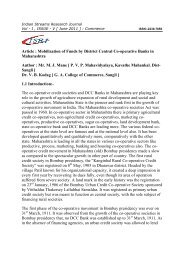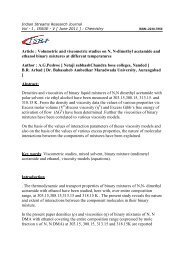Steganography - Indian Streams Research Journal
Steganography - Indian Streams Research Journal
Steganography - Indian Streams Research Journal
You also want an ePaper? Increase the reach of your titles
YUMPU automatically turns print PDFs into web optimized ePapers that Google loves.
Vol III Issue VI July 2013Impact Factor : 0.2105 ISSN No : 2230-7850ORIGINAL ARTICLEMonthly Multidisciplinary<strong>Research</strong> <strong>Journal</strong><strong>Indian</strong> <strong>Streams</strong><strong>Research</strong> <strong>Journal</strong>Executive EditorAshok YakkaldeviEditor-in-chiefH.N.Jagtap
<strong>Indian</strong> <strong>Streams</strong> <strong>Research</strong> <strong>Journal</strong> ISSN 2230-7850Volume-3, Issue-6, July-2013<strong>Steganography</strong> – A Scientific approach to Hide Datawithin data to provide data securityM.Vijaya KumarHEAD OF THE DEPARTMENT, Department of Computer EngineeringDepartment of Technical Education, Govt of Andhra Pradesh, INDIA.Abstract: <strong>Steganography</strong> is derived from the Greek for covered writing and essentially means “to hide in plainsight”. <strong>Steganography</strong> is the art of inconspicuously hiding data within data. The main goal of steganography is tohide information well. In other words <strong>Steganography</strong> is the science that involves communicating secret data in anappropriate multimedia carrier, e.g., image, audio, and video files . The aim is to conceal the very existence of theembedded data .In today's world the art of sending & displaying the hidden information especially in public places,has received more attention and faced many challenges. <strong>Steganography</strong>'s ultimate objectives, which areundetectability, robustness (resistance to various image processing methods and compression) and capacity of thehidden data, are the main factors that separate it from related techniques such as watermarking and cryptography.It is well known that encryption provides secure channels for communicating entities. However, due tolack of covertness on these channels, an unauthorized user can easily identify encrypted streams through statisticaltests and capture them for further cryptanalysis. In cryptography, the individuals notice the information by seeingthe coded information but they will not be able to comprehend the information. However, in steganography, theexistence of the information in the sources will not be noticed at all. Most steganography jobs have been carried outon images, video clips ,texts, music and sounds.Therefore, different methods have been proposed so far for hiding information in different cover media.This method can be used for displaying a secret message in public domains which are accessed by any body.Keyword: Stego file, private marking system, billboard display, Digital image steganography; spatial domain;frequency domain; adaptive steganography, security.INTRODUCTION:1.1 Ancient <strong>Steganography</strong>The word steganography is originally derived fromGreek words which mean “Covered Writing”. Five hundredyears ago, the Italian mathematician Jérôme Cardanreinvented a Chinese ancient method of secret writing. Thescenario goes as follows: a paper mask with holes is sharedamong two parties, this mask is placed over a blank paper andthe sender writes his secret message through the holes thentakes the mask off and fills the blanks so that the messageappears as an innocuous text.other methods, information security has improvedconsiderably. <strong>Steganography</strong> can also be used in copyright,preventing e-document forging etc applications.<strong>Steganography</strong> – A Scientific approach to Hide Data within data toprovide data securityM.vijaya Kumar1.2 NomenclatureThe term “cover image” will be used throughoutthis paper to describe the image designated to carry theembedded bits. We will be referring to an image withembedded data, called herein payload, as “stego-image”.Further “steganalysis” or “attacks” refer to different imageprocessing and statistical analysis approaches that aim tobreak or attack steganography algorithms.With the development of computer and expandingits use in different areas of life and work, the issue ofinformation security has become increasingly important.One of the grounds discussed in information security is theexchange of information through the cover media. To thisend, different methods such as cryptography, steganography,coding, etc have been used.The main goal of steganographyis to hide information in the other cover media so that otherperson will not notice the presence of the information.Nowadays, using a combination of steganography and theHaving produced the stego object, it will then besent off via some communications channel, such as email, tothe intended recipient for decoding. The recipient mustdecode the stego object in order for them to view the secretinformation. The decoding process is simply the reverse ofthe encoding process. It is the extraction of secret data from astego object. In the decoding process, the stego object is fedin to the system. The public or private key that can decode theoriginal key that is used inside the encoding process is alsoneeded so that the secret information can be decoded. Afterthe decoding process is completed, the secret informationembedded in the stego object can then be extracted andviewed.In steganography the Image can be more than whatwe see with our Human Visual System (HVS); hence, theycan convey more than merely 1000 words. Three techniquessteganography, watermarking and cryptography are1
<strong>Indian</strong> <strong>Streams</strong> <strong>Research</strong> <strong>Journal</strong> ISSN 2230-7850Volume-3, Issue-6, July-2013interlinked, The first two are quite difficult to tease apartespecially for those coming from different disciplines.Description of the algorithm for embedding the secretmessage:<strong>Steganography</strong> – A Scientific approach to Hide Data within data toprovide data securityM.vijaya KumarThe main goal of this method is to hide informationon the output image of the instrument (such as imagedisplayed by an electronic advertising billboard). Thismethod can be used for announcing a secret message in apublic place. In general, this method is a kind ofsteganography, but it is done in real time on the output of adevice such as electronic billboard. Following are the stepsinvolved in embedding the secret information within a covermedia.a) Send the normal data that has to be displayed to the displayboard.b) Using a suitable <strong>Steganography</strong> algorithm hide the secretdata within the normal data before sending it to the displayboard. This method can be used for announcing a secretmessage in public place. It can be extended to other meanssuch as electronic advertising board around sports stadium.Algorithm for embedding the secret message is asfollows:a) Read the image from the source.b) Divide the image into [R x C] smaller blocks .Where R &Care the first & second bytes of the key respectivelyc)Each smaller block is a combination of many pixels ofdifferent values.d) The LSBs of the pixel are changed depending on thepattern bits and the secret message bits.e)The pattern bits are considered in sequence form its MSB.f)If the pattern bit is 0, then the first LSB of the pixel ischanged [i.e if data bit is 1 and pixel bit is 0 then pixel bit ischanged to1 or else it is retained as it is.]g) If the pattern bit is 1, then the second LSB of the pixel ischanged accordingly.h) A single bit of the secret message is distributed through outthe block. This is done to have enough information so thatcorrect information can be retrived after decodingi)Similarly the other bits are inserted in the remaining blocks.j)If the length of the secret message is large , then it can bedivided and stored in two or three frames.2
<strong>Indian</strong> <strong>Streams</strong> <strong>Research</strong> <strong>Journal</strong> ISSN 2230-7850Volume-3, Issue-6, July-2013k) To extract the information, operations contrary to the onescarried out in embedding are performed. The key plays a veryimportant in embedding the message. Larger the key size, themore difficult to suspect the secrecy.The figure above shows how the key is generated.The first 8 bits in red colour represent the no. of rows R & thenext 8 bits in blue color represents the no. of columns C. The16 bits in green followed by row and column represent thepattern bits. Each whole block of the cover image includesonly one bit of the secret data. This is done so that moreamounts of data is available During retrieval.2.STEGANOGRAPHY APPLICATIONS<strong>Steganography</strong> is employed in various usefulapplications, e.g., copyright control of materials, enhancingrobustness of image search engines and smart IDs (identitycards) where individuals' details are embedded in theirphotographs. Other applications are video-audiosynchronization, companies' safe circulation of secret data,TV broadcasting, TCP/IP packets (for instance a unique IDcan be embedded into an image to analyze the network trafficof particular users) [1], and also checksum embedding [15].Petitcolas [16] demonstrated some contemporaryapplications, one of which was in Medical Imaging Systemswhere a separation is considered necessary forconfidentiality between patients' image data or DNAsequences and their captions, e.g., physician, patient's name,address and other particulars. A link however, must bemaintained between the two. Thus, embedding the patient'sinformation in the image could be a useful safety measureand helps in solving such problems. <strong>Steganography</strong> wouldprovide an ultimate guarantee of authentication that no othersecurity tool may ensure data hiding.CONCLUSIONS AND SUMMARYThis paper presented a background discussionsteganofraphy, its methodology and applicationons.stganography deployed in digital imaging. The emergingtechniques such as DCT, DWT and Adaptive steganograsphyare not too prone to attacks, especially when the hiddenmessage is small. This is because they alter coefficients in thetransform domain, thus image distortion is kept to aminimum. Generally these methods tend to have a lowerpayload compared to spatial domain algorithms. There aredifferent ways to reduce the bits needed to encode a hiddenmessage. Apparent methods can be compression orcorrelated steganography.<strong>Steganography</strong> methods usually struggle withachieving a high embedding rate. As an alternative channel toimages, video files have many excellent features forinformation hiding such as large capacity and goodimperceptibility. The challenge, however, is to be able toembed into a group of images which are highly intercorrelatedand often manipulated in a compressed form.As steganography becomes more widely used incomputing, there are issues that need to be resolved. Thereare a wide variety of different techniques with their ownadvantages and disadvantages. Many currently usedtechniques are not robust enough to prevent detection andremoval of embedded data. The use of benchmarking toevaluate techniques should becomFor a system to be considered robust it should havethe following properties:a) The quality of the media should not noticeably degradeupon addition of a secret data.b) Secret data should be undetectable without secretknowledge, typically the key.c) If multiple data are present they should not interfere witheach other.d) The secret data should survive attacks that don't degradethe perceived quality of the work.This work presents a scheme that can transmit largequantities of secret information and provide securecommunication between two communication parties. Bothsteganography and cryptography can be oven into thisscheme to make the detection more complicated. Any kind oftext data can be employed as secret msg. The secret messageemploying the concept of steganography is sent over thenetwork .In addition, the proposed procedure is simple andeasy to implement. Also, the developed system has manypractical, personal and militaristic applications for bothpoint-to-point and point-to-multi-point communicationsREFERENCESI] Mohammad Shirali-Shahreza , “A new method for realtime steganography”, ICSP 2006 Proceedings of IEEE .II] Yuk Ying Chung, fang Fei Xu , “Development of videowatermarking for MPEG2 video” City university of HongKong ,IEEE 2006.III] C. Lu, J. Chen and K. Fan, "Real-time Frame-DependentVideo Watermarking in VLC Domain", Signal Processing :Image Communication 20, 2005, pp. 624–642.IV]. Jonathan Cummins, Patrick Diskin, Samuel Lau andRobert Parlett,“<strong>Steganography</strong> and digital watermarking”School of Computer Science, The University ofBirmingham. 2003.www.cs.unibo.it/people/phdstudents/scacciag/home_files/teach/datahide.pdf.V] Ravi shah , Abhinav Agraval & subramaniam Ganesham,“Frequency domain real time digital image watermarking “Oakland university.VI] C. Lu, J. Chen, H. M. Liao, and K. Fan, "Real-TimeMPEG2 Video Watermarking in the VLC Domain", Proc.of16th International Conference on Pattern Recognition, Vol.2, 11-15 August 2002, pp. 552-555.3<strong>Steganography</strong> – A Scientific approach to Hide Data within data toprovide data securityM.vijaya Kumar
<strong>Indian</strong> <strong>Streams</strong> <strong>Research</strong> <strong>Journal</strong> ISSN 2230-7850Volume-3, Issue-6, July-2013VII] J. Haitsma and T. Kalker, "A Watermarking Scheme forDigital Cinema",Proceedings of the IEEE InternationalConference on Image Processing, Vol. 2, 2001, pp. 487–489.VIII] Christoph Busch ,Wolfgang Funk & StephenWolthusen ,“DigitalWatermarking from concepts to Real -Time Video applications”, IEEE Computer graphics andapplications 1999.IX] Chen Ming ,Zhang Ru, Niu Xinxin,Yang Yixian,“Analysis of current steganography tools: Classification &features” ,Information security center,BeijingUniversity.China.X] S. Katzenbeisser, F.A.P. Petitcolas (Ed.), InformationHiding Techniques for <strong>Steganography</strong> and DigitalWatermarking, Artech House Books, ISBN 1-58053-035-4,2000. Proceedings of 2001 International Conference onImageProcessing, Thessaloniki, Greece, 2001, pp. 542–545.<strong>Steganography</strong> – A Scientific approach to Hide Data within data toprovide data securityM.vijaya Kumar4
Publish <strong>Research</strong> ArticleInternational Level Multidisciplinary <strong>Research</strong> <strong>Journal</strong>For All SubjectsDear Sir/Mam,We invite unpublished research paper.Summary of <strong>Research</strong>Project,Theses,Books and Books Review of publication,you will be pleased toknow that our journals areAssociated and Indexed,IndiaInternational Scientific <strong>Journal</strong> ConsortiumOPEN J-GATEScientificAssociated and Indexed,USAGoogle ScholarEBSCODOAJIndex CopernicusPublication IndexAcademic <strong>Journal</strong> DatabaseContemporary <strong>Research</strong> IndexAcademic Paper DatabseDigital <strong>Journal</strong>s DatabaseCurrent Index to Scholarly <strong>Journal</strong>sElite Scientific <strong>Journal</strong> ArchiveDirectory Of Academic ResourcesScholar <strong>Journal</strong> IndexRecent Science IndexScientific Resources Database<strong>Indian</strong> <strong>Streams</strong> <strong>Research</strong> <strong>Journal</strong>258/34 Raviwar Peth Solapur-413005,MaharashtraContact-9595359435E-Mail-ayisrj@yahoo.in/ayisrj2011@gmail.comWebsite : www.isrj.net
















